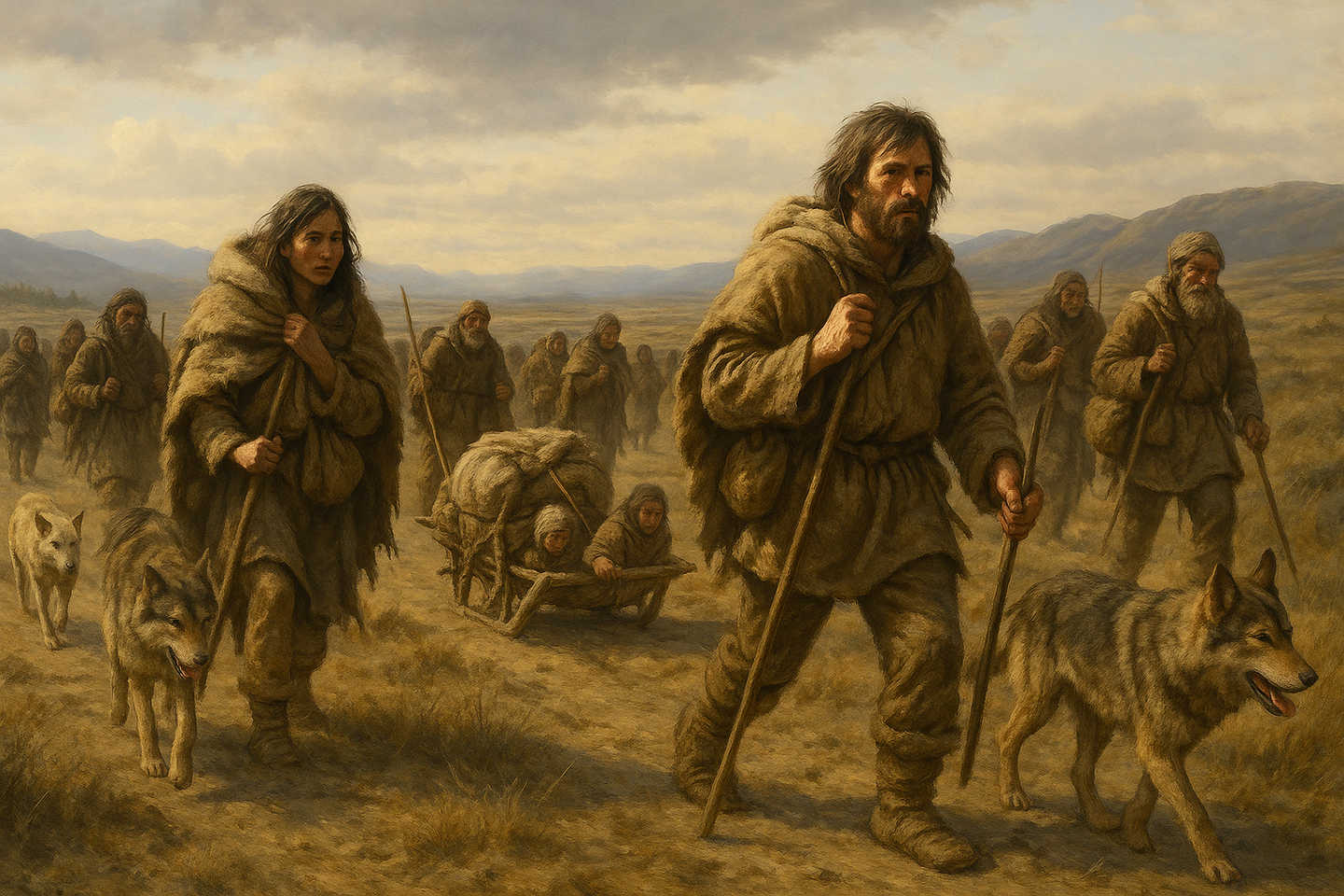Ancient DNA shows dogs and people migrated together across Eurasia
A new genetic study reveals that ancient dogs moved with people across Eurasia, offering a vivid look at shared human and animal history.

 Edited By: Joshua Shavit
Edited By: Joshua Shavit

Ancient DNA reveals how dogs moved with people across Eurasia for 10,000 years. (CREDIT: AI-generated image / The Brighter Side of News)
Long before written history, early families moving across Eurasia kept dogs close as companions and helpers. A sweeping new study offers the clearest evidence yet that the history of dogs is intertwined with the migrations and cultural changes that shaped the continent. By sequencing 73 ancient dogs, including 17 that had never been analyzed before, an international research team traced how different dog lineages traveled and mixed as people farmed, hunted, traded, and built new worlds over nearly 10,000 years.
Dogs were living in Europe with humans approximately 11,000 years ago, and not long after, dogs were alongside people in Eastern Siberia. Genetic analyses reveal that the most recent common ancestor of modern dogs had already split into Eastern and Western lineages more than 20,000 years ago. These early, distinct lineages became part of the cultural packages carried by hunter-gatherers, and later farmers and pastoralists, who were moving across Eurasia.
The current investigation focused specifically on ancient dogs from East Asia, the West Eurasian Steppe, and Eastern Siberia, regions that underwent significant shifts in the human ancestry after the last Ice Age. By correlating ancient dog genomes with ancient human genomes from the same geographical areas, the researchers discovered multiple instances of overlap between ancestry changes derived from the dog genome analysis and changes noted in the human genome analysis.
For example, one dog recovered from the Khatystyr cave in Southeast Siberia, which lived approximately 9,700 years ago, was most closely related to another dog that was recovered from the distant Zhokhov Island, located far northeast of Khatystyr cave. Their common ancestry suggests long-distance relationships not only among the dog lineage in the samples but also among human groups, who carried Ancient Paleo Siberian ancestry.
Waves of Change in Northern China
Numerous migrations occurred in Northern China during the Neolithic and Bronze Age, as agriculture surfaced and evolved out of independent domesticates and a blending of herders, farmers, and "newcomers" from the Steppe. The same narrative exists in the dog ancestry carried by these archaeological specimens.
Domesticates, including dogs, from the Yabeili and Jinchankou sites within the Upper Yellow River area, dating to between 5,000 to 3,900 years ago, indicated a mixture of ancestry. One Yabeili dog did not present as designed to show Western ancestry. The Jinchankou ancestry exhibited a much stronger Arctic signal, which ranged from approximately 38 percent to 45 percent depending on the model used.
The remaining ancestry in the Jinchankou dogs came from East Asian dog lines. The genetic connection to the Arctic complements known human movements from that time. People of the Qijia culture had been subjected to an influx of Northeast Asian ancestry stemming from the Lake Baikal area, and the very same anatomical routes likely applied to their dogs' genetic ancestry.
Shifting Histories in the Eurasian Steppe
The Eurasian Steppe is associated with radical shifts in culture and population. Early groups of domesticates had lived with ancestry related to Eastern hunter-gatherers and Northeast Asian groups. Later, Bronze Age groups with ancestry tied to Iranian Farmers and Caucasus hunter-gatherers moved in. Dogs would have experienced these same shifts.
A particularly striking example comes from a Botai culture dog roughly dated to 5200 years ago in what is now modern-day Kazakhstan. This dog carries approximately 75 percent Arctic ancestry with an accompanying 25 percent Western ancestry.
The inhabitants of Botai lacked any trace of ancestry derived from Iranian agriculturalists or Caucasus hunter-gatherers, which implies the dog's western ancestry was independent of the later ties of eastern European hunter-gatherers. The presence of dogs was evidently incorporated into early communities prior to any significant migrations in the Bronze Age.
By the late Bronze Age, western dog ancestry had become widespread on the Steppe. In some cases, dogs from the Srubnaya culture show more than 60 percent ancestry in the western lineage as well as smaller amounts of East Asian and Arctic lineages. A dog from Kent in Kazakhstan dated to 3,200 years ago, had 70 percent western and 30 percent Arctic dog ancestry. Even a medieval dog from Bolgar, a milestone site of trade on the Volga River, exhibited a similar dog ancestry mix.
Western Dogs Carrying Eastward to New Corners of China
When western steppe pastoralists moved east, their dogs went with them. This change is reflected in the genomes of a 3,300-year-old dog from Jirentaigoukou in Xinjiang, which had similar amounts of Western and East Asian ancestry. Human genomes from the same site had an even greater connection to Andronovo and Sintashta groups of the steppe.
In the Hexi Corridor, where the movements of western pastoralists and their dogs overlapped with distinct communities, dogs had between 15 and 35 percent western ancestry hounds, amidst coexisting East Asian lineages. The western ancestry catchment in that area appears to have entered the region 3,800 to 4,000 years ago.
However, it does become clear that not every nearby community followed the same course. The Jinchankou dog, which is native only a few hundred kilometers away, provides no solid trace of western ancestry. This inconsistency indicates the gradual diffusion of Western dogs into China, some at notably earlier periods than elsewhere.
By the time of the Liao dynasty, about 850 years ago, dogs in Inner Mongolia carried genes of western ancestry at about 40 percent. This number resembles the ancestry found in many present-day dogs from suitably northern regions of China. Moreover, the study makes note of the fact that modern dogs may have more recent ancestors that are not visible in ancient samples.
Ancient Histories of Dogs and Humans
For most of the last 10,000 years, the histories of humans and dogs moved together. Paleo Siberian, Northeast Asian, and East Asian people were much more likely to keep dogs of East Asian or Arctic ancestry. Westerners kept Western dogs. However, these patterns did not align perfectly. Eastern hunter-gatherers from the Veretye and Botai, who were more closely related to Westerners, kept dogs that were predominantly northern Arctic in their ancestry.
Likewise, from Lake Baikal, humans that were more East Asian in ancestry kept dogs that clustered with Arctic dogs far to their north. These mismatches reflect possible trading networks and special uses, and demonstrate that dogs moved independently of human ancestry.
Though their findings have focused on dogs, the new study published in Science, led by Laurent Frantz of Ludwig Maximilian University of Munich and Queen Mary University in London, shows ancient dogs can be a tool for examining significant changes in human culture. The study team includes scientists from LMU, QMUL, the Kunming Institute of Zoology, Lanzhou University, and the University of Oxford. They found that dog lineages shifted in association with the emergence of metal working in China approximately 4,000 years ago, as the metal working culture spread from the western Steppe into China.
According to Dr. Lachie Scarsbrook of LMU and Oxford, "traces of these changes in human culture may be read in dog genomes." He pointed out that people kept their own dog lineages, rather than adopt the lineage of their recent companions, as an example. Frantz added that dogs and humans constitute a particularly flexible bond across time, whether in the Arctic Circle or in early cities.
Future Directions of Research
This research also gives you a deeper way to think about the long history of partnerships between humans and animals.
By comparing patterns of ancestry in human genomes and dog genomes, scientists can start to differentiate details with respect to ancient migrations and with respect to changes in human culture.
These types of discoveries may inform future research on how domesticated species influenced human history, and simultaneously how human societies influenced the evolution of animals that lived amongst them, human-adaptive evolution.
Research findings are available online in the journal Science.
Related Stories
- Denisovan jawbone discovery unlocks secrets of ancient human migration
- Ancient human fossils reveal a startling twist in evolutionary history
- New discoveries show Neanderthals and Homo sapiens lived—and died—together
Like these kind of feel good stories? Get The Brighter Side of News' newsletter.
Joseph Shavit
Science News Writer, Editor-At-Large and Publisher
Joseph Shavit, based in Los Angeles, is a seasoned science journalist, editor and co-founder of The Brighter Side of News, where he transforms complex discoveries into clear, engaging stories for general readers. With experience at major media groups like Times Mirror and Tribune, he writes with both authority and curiosity. His work spans astronomy, physics, quantum mechanics, climate change, artificial intelligence, health, and medicine. Known for linking breakthroughs to real-world markets, he highlights how research transitions into products and industries that shape daily life.



